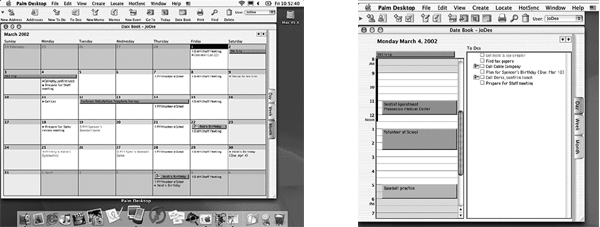Palm Desktop is another complete software suite that deserves to be mentioned. Its main purpose is to synchronize any desktop PIM software with a Palm Pilot.
The Palm Pilot was one of the first PIM devices available, long before other devices such as mobile phones learned the capabilities for holding a sufficient amount of personal information.
This new device also had the capabilities to load new programs and extend its functionality. Therefore a communication with a PC and some kind of transmission program had to be build.
And, most important, people would not enter all their data in the Palm Pilot itself, but rather wanted to use a full size keyboard and their desktop PIM programs.
So, Palm made a software that could do all that: load programs, backup data, and synchronize it with other databases. In case you do not have another database, the Palm Desktop program itself is a complete PIM solution: It has a calender, address book, and to-do list build in.
All other software can be synchronized with a Palm Pilot via plug-ins. Such a plug-in is called Conduit. Conduits exist for almost all PC organizers, such as Outlook, Gnome-pim, and KOrganizer.
Palm Desktop has two major shortcomings: The first one is very obvious: It only works with devices that run Palm OS. This leaves out the second mayor PIM device platform Windows CE and all current cell phones.
The second shortcoming is that Palm Desktop is build for synchronization of the Palm Pilot with only one database. You could synchronize one Palm Pilot with two computers, for example at work and at home, but this gives very strange results when it comes to things such as deleting database entries.
Palm Desktop provides an extensible platform. It is a very good tool to access the data on a Palm Pilot. The conduit concept makes it easy to extend, and this is what I would use in future versions to access data on a Pilot.
